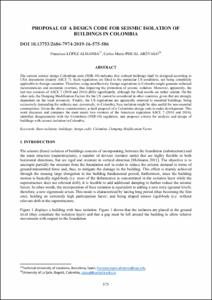Mostra el registre d'ítem simple
Proposal of a design code for seismic isolation of buildings in Colombia
| dc.contributor.author | López Almansa, Francisco |
| dc.contributor.author | Piscal Arévalo, Carlos Mario |
| dc.contributor.other | Universitat Politècnica de Catalunya. Departament de Tecnologia de l'Arquitectura |
| dc.coverage.spatial | east=-74.297333; north=4.570868; name=Soacha, Cundinamarca, Colòmbia |
| dc.date.accessioned | 2020-06-02T17:01:10Z |
| dc.date.available | 2020-06-02T17:01:10Z |
| dc.date.issued | 2019 |
| dc.identifier.citation | Lopez Almansa, F.; Piscal, C. M. Proposal of a design code for seismic isolation of buildings in Colombia. A: World Conference on Seismic Isolation, Energy Dissipation and Active Control of Vibrations of Structures. "The 16th World Conference on Seismic Isolation, Energy Dissipation and Active Vibration Control of Structures: Ppoceedings of the conference". 2019, p. 575-586. |
| dc.identifier.uri | http://hdl.handle.net/2117/189758 |
| dc.description.abstract | The current seismic design Colombian code (NSR-10) indicates that isolated buildings shall be designed according to USA documents (mainly ASCE 7). Such regulations are fitted to the particular US conditions, not being completely applicable to foreign countries. Therefore, using unreflexively foreign regulations in Colombia might generate technical inconsistencies and economic overruns, thus impairing the promotion of seismic isolation. Moreover, apparently, the last two versions of ASCE 7 (2010 and 2016) differ significantly, although the final results are rather similar. On the other side, the Damping Modification Factors for the US cannot be considered in other countries, given that are strongly dependent on the local seismicity. Finally, the US regulations are apparently oriented to essential buildings, being excessively demanding for ordinary use; conversely, in Colombia, base isolation might be also useful for non-essential constructions. Given the above considerations, a draft proposal of a Colombian design code is under development. This work discusses and compares the most recent two versions of the American regulation ASCE 7 (2010 and 2016), identifies disagreements with the Colombian (NSR-10) regulation, and proposes criteria for analysis and design of buildings with seismic isolation in Colombia. |
| dc.format.extent | 12 p. |
| dc.language.iso | eng |
| dc.rights | Attribution-NonCommercial-NoDerivs 3.0 Spain |
| dc.rights.uri | http://creativecommons.org/licenses/by-nc-nd/3.0/es/ |
| dc.subject | Àrees temàtiques de la UPC::Enginyeria civil::Geotècnia::Sismologia |
| dc.subject | Àrees temàtiques de la UPC::Edificació::Elements constructius d'edificis::Elements estructurals d'edificis |
| dc.subject.lcsh | Earthquake engineering |
| dc.subject.lcsh | Earthquake resistant design |
| dc.subject.other | Base isolation |
| dc.subject.other | Buildings |
| dc.subject.other | Design code |
| dc.subject.other | Colombia |
| dc.subject.other | Damping Modification Factor |
| dc.title | Proposal of a design code for seismic isolation of buildings in Colombia |
| dc.type | Conference report |
| dc.subject.lemac | Enginyeria sísmica |
| dc.subject.lemac | Disseny antisísmic |
| dc.contributor.group | Universitat Politècnica de Catalunya. GMNE - Grup de Mètodes Numèrics en Enginyeria |
| dc.identifier.doi | 10.13753/2686-7974-2019-16-575-586 |
| dc.description.peerreviewed | Peer Reviewed |
| dc.relation.publisherversion | http://www.16wcsi.org/ |
| dc.rights.access | Open Access |
| local.identifier.drac | 28596602 |
| dc.description.version | Postprint (published version) |
| local.citation.author | Lopez Almansa, F.; Piscal, C. M. |
| local.citation.contributor | World Conference on Seismic Isolation, Energy Dissipation and Active Control of Vibrations of Structures |
| local.citation.publicationName | The 16th World Conference on Seismic Isolation, Energy Dissipation and Active Vibration Control of Structures: Ppoceedings of the conference |
| local.citation.startingPage | 575 |
| local.citation.endingPage | 586 |


